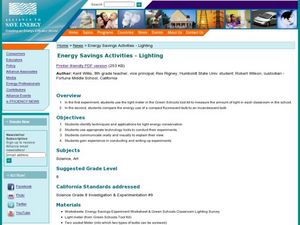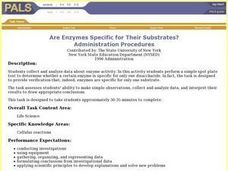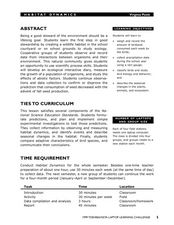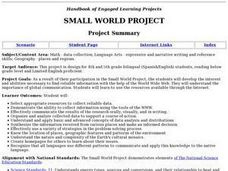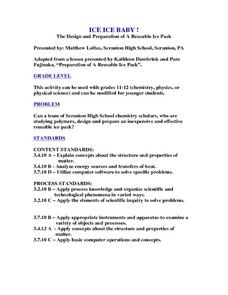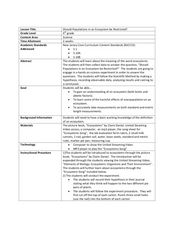Curated OER
Energy Saving activities Lighting
Eighth graders study how light emits energy. In this energy savings lesson plan, 8th graders conduct two experiments to find ways to save energy. In one experiment students measure the light in each classroom and make recommendations for...
Curated OER
Science: Fossil of a Carbonized Plant
Students classify leaves by shape and margins and use them to create models of plant fossils. By using paper over a leaf, they simulate fossilization of organisms onto sedimentary rocks. Following instructions on worksheets, students...
Curated OER
Are Enzymes Specific for Their Substrates?
Students discover enzyme to substrate specificity. The experiment uses samples of glucose and lactose in combination with the enzyme lactase. Students observe the reaction between the lactose and the lactase; the lack of a reaction...
Curated OER
Pedestrian Safety for Students
Young scholars create a spreadsheet. In this spreadsheet lesson, students take the responses they received from a pedestrian safety survey to create their spreadsheet. Then they turn this information into a graph.
Curated OER
Home Sweet Home
Students examine the change in the diversity of animals living in an area before and after development. In order to do this, students need to have access to an area near their school which is undeveloped. A good, "real life" lesson.
Curated OER
Energy in Today's Global Society
Students explain how heat is used to generate and produce electricity. For this energy lesson students complete several activities that show them about the different fuels used for heating.
Curated OER
Habitat Dynamics
Students develop an interactive diary to record bird seed consumption. In this habitat lesson, students predict and record the amount of birdseed eaten each week by birds.
Curated OER
Small World Project
Students participate in the Small World Project that develops their interest and abilities necessary to find reliable information from the Internet and through global communication. They develop homepages, research topics, and produce a...
Curated OER
Cranes, Crosswalks, and Big Gulps
Students watch a video and answer questions based on wildlife jobs. In this wildlife lesson plan, students learn that biologists don't just play with animals but that there is a lot of study involved.
Curated OER
Clean Air: Our Health Matters
Students learn about the human respiratory system. In this pollution instructional activity, students identify the parts of the respiratory system and what happens to them when they breathe in polluted air. Students learn about the...
Curated OER
Ice Ice Baby! The Design and Preparation of A Reusable Ice Pack
Pupils explore polymers by designing and preparing an inexpensive and effective reusable ice pack. They develop and test a design for a reusable ice pack in the science lab. Students apply chemical and physical properties of polymers and...
Curated OER
Hypothesize This!
Students role play scientists to prove a hypotheses. They determine whether or not walruses stay warmer in water or in air. Students also determine in which environment they lose more body heat.
Curated OER
Under The Sea
Second graders study how a tsunami is formed by underwater events such as earthquakes, volcanoes or landslides. They discuss what they knew about living and non-living things in the ocean.
Curated OER
Continents Adrift
Students examine how tectonic plates change the Earth's land. In this geology instructional activity, students are divided into small groups to construct a continent puzzle. Students use transparency pieces to demonstrate how Africa and...
Curated OER
Simple Harmonic Motion with Dr. DAQ
Students study the work and accomplishment of Galileo. In this physics lesson, students calculate the period of a pendulum's using a mathematical equation. They explain the different factors affecting its period.
Curated OER
Ziplock Chemistry
Students investigate various chemical reactions when creating mixtures in ziplock baggies. In this chemistry lesson, students will recognize various chemical reactions and cite evidence. Safety and assessment strategies are included in...
Curated OER
Skeletal System
Seventh graders identify and label twenty-five bones of the skeletal system. In small groups they glue various types of dried pasta to a large human body outline. They attach the pasta to the outline and label the pasta bones.
Curated OER
Reading Satellite Images
Students analyze satellite images. For this astronomy lesson, students examine 3 satellite images in order to understand how satellite images are taken and what they can teach scientists.
Curated OER
DISCOUNT LENSES ( GELATIN WAVE GUIDES)
Students study attributes associated with concept of fiber optics is done using a labmade fiber optic from clear molded gelatin. A variety of shapes can be cut and pieced together to form a conduit to transmit the laser beam by internal...
Curated OER
How Machines Help Us Stay Healthy
Students visit different departments at a local hospital to see how machines help peoples such as the CAT scan machine. They build a model of such a machine that shows how patients are moved in and out of the machine.
Curated OER
Population Growth
Students grow duckweed, observe what happens when an organism population is allowed to grow without predation or competition, view videos about invasive species, and develop a proposal for controlling the growth of an invasive species in...
Curated OER
Local Weather And Location
Young scholars explain how uneven heating of Earth affects wind and water currents. They describe the limits on current technology in predicting weather and how the Water Cycle is related to local weather.
Curated OER
Scientist Tracking Network
Students correlate surface radiation with mean surface temperature of several geographic regions. They observe how these parameters change with latitude and construct an understanding of the relationship of solar radiation to seasonal...
Curated OER
Should Populations in an Ecosystem be Restricted?
Fourth graders experiment to determine how overpopulation effects ecosystems specifically plants. In this ecosystem lesson, 4th graders conduct an ecosystems experiment after listening to Claire Daniel's, Ecosystems. They watch a video,...


